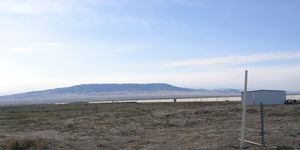لايگو (مرصد)
| أسماء بديلة | LIGO |
|---|---|
| المو(ا)قع | Hanford Site, Washington and Livingston, Louisiana, US |
| الإحداثيات | LIGO Hanford Observatory: 46°27′18.52″N 119°24′27.56″W / 46.4551444°N 119.4076556°W LIGO Livingston Observatory: 30°33′46.42″N 90°46′27.27″W / 30.5628944°N 90.7742417°W |
| الهيئة | LIGO Scientific Collaboration |
| طول الموجة | - |
| أول ضوء | 2002-08-23 |
| نمط التلسكوپ | مرصد الموجة الثقالية مقياس التداخل الفلكي منشأة |
| الموقع الإلكتروني | www |
LIGO observatories in the Contiguous United States | |
مرصد الموجات التثاقلية بمقياس التداخل الليزري Laser Interferometer Gravitational-Wave Observatory (LIGO) هو تجربة فيزياء واسعة النطاق ومرصد للعثور على الموجات التثاقلية الكونية و لتطوير أرصاد بالموجات التثاقلية كأداة فلكية.[1] تم بناء مرصدين ضخمين في الولايات المتحدة بهدف التحقق من الموجات التثاقلية عن طريق مقياس التداخل الليزري. يمكن لهذا المرصد الكشف عن تغير في مرآة بقطر 4 كم بتباعد أقل من عشرة آلاف charge diameter من الپروتون، المكافئ لقياس المسافة إلى القنطور الأكبر بدقة أقل من عرض شعر الرأس البشري.[2]
تم تأسيس أول مراصد اللايگو عن طريق المؤسسة الوطنية للعلوم ووضع تصورها، وقام بنائها، وتشغيلها معهد كاليفورنيا للتكنولوجيا ومعهد مساتشوستس للتكنولوجيا.[3][4] قاموا بجمع بيانات من 2002 حتى 2010 لكن لم يتم الكشف عن أي موجات تثاقلية.
يهدف مشروع لايگو المتقدم إلى تعزيز مكشافات لايگو الأصلية والذي بدأ في 2008 مع استمرار دعم المؤسسة الوطنية للعلوم، في ظل إسهامات هامة من مجلس مرافق العلوم والتكنولوجيا في المملكة المتحدة، جمعية ماكس پلانك في ألمانيا، ومجلس الأبحاث الأسترالي.[5][6] بدأت الكاشفات المحسنة في العمل عام 2015. وُضع تقرير عن الموجات التثاقلية في 2016 من قبل LIGO Scientific Collaboration (LSC) وVirgo Collaboration بمشاركة دولية لعلماء من مختلف الدول والمؤسسات البحثية. يشارك العلماء في المشروع ويتم تنظيم تحليل البيانات الواردة من gravitational-wave astronomy بواسطة LSC، والذي يضم ما يزيد عن 1000 عالم من مختلف أنحاء العالم،[7][8][9] بالإضافة إلى 440,000 من مستخدمي Einstein@Home النشطون، في قالب:Of.[10]
يعتبر لايگو أكبر وأكثر المشروعات الطموحة التي تمولها المؤسسة الوطنية للعلوم.[11][12]
المهمة

المراصد
يـُشـَغـَِـل ليگو مرصدين للموجات التثاقلية.
التشغيل
قالب:Gravitational wave observatory principle.svg
أرصاد
لايگو المحسـّن
لايگو المتقدم
بعد 2010، ظل لايگو خارج الخدمة لعدة سنوات من أجل عملية تحديث كبرى، وتحميل كواشف لايگو المتقدمة الجديدة داخل البنية التحتية لمرصد لايگو.
لايگو-الهند
المستكشف الكوني
تصميم مرفق أكبر بأذرع أكثر طولاً والذي يسمى "كوسميك إكسپلورر"، والذي من شأنه أن يحسن مقترح تلكسوپ أينشتاين الأوروپي. يعتمد هذا على تقنية لايگو ڤواياج، لكن تم تمديدها an ET-like triangular configuration بذراعين بطول 40 كم.[14]
انظر أيضاً
- تلسكوپ أينشتاين، كاشف موجات تثاقلية أوروپي من الجيل الثالث.
- أينشاتين@هوم، برنامج حوسبة volunteer distributed يمكن للشخص تنزيله لمساعدة فرق لايگو/جيو على تحليل بياناتهم.
- GEO600، كاشف موجات تثاقلية يقع في هانوڤر، ألمانيا.
- Holometer
- اختبارات النسبية العامة
- Virgo interferometer، مقياس تداخلي يقع بالقرب من پيزا، إيطاليا.
- LISA Pathfinder
الهامش
- ^ Barish, Barry C.; Weiss, Rainer (October 1999). "LIGO and the Detection of Gravitational Waves". Physics Today. 52 (10): 44. Bibcode:1999PhT....52j..44B. doi:10.1063/1.882861.
- ^ "Facts". LIGO.
LIGO is designed to detect a change in distance between its mirrors 1/10,000th the width of a proton! This is equivalent to measuring the distance to the nearest star to an accuracy smaller than the width of a human hair!
- ^ "LIGO Lab Caltech MIT". Retrieved 24 June 2016.
- ^ "LIGO MIT". Retrieved 24 June 2016.
- ^ "Major research project to detect gravitational waves is underway". University of Birmingham News. University of Birmingham. Retrieved 28 November 2015.
- ^ Shoemaker, David (2012). "The evolution of Advanced LIGO" (PDF). LIGO Magazine (1): 8.
- ^ "Revolutionary Grassroots Astrophysics Project "Einstein@Home" Goes Live". Retrieved 3 March 2016.
- ^ "LSC/Virgo Census". myLIGO. Retrieved 28 November 2015.
- ^ خطأ استشهاد: وسم
<ref>غير صحيح؛ لا نص تم توفيره للمراجع المسماةNature_2015_Sept_15 - ^ "BOINCstats project statistics". Retrieved 14 December 2016.
- ^ Larger physics projects in the United States, such as Fermilab, have traditionally been funded by the Department of Energy.
- ^ LIGO Fact Sheet at NSF
- ^ Moore, Christopher; Cole, Robert; Berry, Christopher (19 July 2013). "Gravitational Wave Detectors and Sources". Retrieved 20 April 2014.
- ^ خطأ استشهاد: وسم
<ref>غير صحيح؛ لا نص تم توفيره للمراجع المسماةISWP15
خطأ استشهاد: الوسم <ref> ذو الاسم "PRL-20160211" المُعرّف في <references> غير مستخدم في النص السابق.
<ref> ذو الاسم "Nature_11Feb16" المُعرّف في <references> غير مستخدم في النص السابق.المراجع
- Kip Thorne, ITP & Caltech. Spacetime Warps and the Quantum: A Glimpse of the Future. Lecture slides and audio
- Barry C. Barish, Caltech. The Detection of Gravitational Waves. Video from CERN Academic Training Lectures, 1996
- Barry C. Barish, Caltech. Einstein's Unfinished Symphony: Sounds from the Distant Universe Video from IHMC Florida Institute for Human Machine Cognition 2004 Evening Lecture Series.
- Rainer Weiss, Electromagnetically coupled broad-band gravitational wave antenna, MIT RLE QPR 1972
- On the detection of low frequency gravitational waves, M.E.Gertsenshtein and V.I.Pustovoit – JETP Vol.43 p. 605-607 (August 1962) Note: This is the first paper proposing the use of interferometers for the detection of gravitational waves.
- Wave resonance of light and gravitational waves – M.E.Gertsenshtein – JETP Vol.41 p. 113-114 (July 1961)
- Gravitational electromagnetic resonance, V.B.Braginskii, M.B.Mensky – GR.G. Vol.3 No.4 p. 401-402 (1972)
- Gravitational radiation and the prospect of its experimental discovery, V.B.Braginsky – Soviet Physics Vol.86 p. 433-446 (July 1965)
- On the electromagnetic detection of gravitational waves, V.B.Braginsky, L.P.Grishchuck, A.G.Dooshkevieh, M.B.Mensky, I.D.Novikov, M.V.Sazhin and Y.B.Zeldovisch – GR.G. Vol.11 No.6 p. 407-408 (1979)
- On the propagation of electromagnetic radiation in the field of a plane gravitational wave, E.Montanari – gr-qc/9806054 (11 June 1998)
للاستزادة
- Barish, Barry C. (2000). "The Science and Detection of Gravitational Waves" (PDF).
- Bartusiak, Marcia (2000). Einstein's unfinished symphony : listening to the sounds of space-time. Washington, D.C: Joseph Henry Press. ISBN 0-425-18620-2.
- Saulson, Peter (1994). Fundamentals of interferometric gravitational wave detectors. Singapore River Edge, N.J: World Scientific. ISBN 981-02-1820-6.
- Collins, Harry M. (2004). Gravity's shadow the search for gravitational waves. Chicago: University of Chicago Press. ISBN 0-226-11378-7.
- Kennefick, Daniel (2007). Traveling at the speed of thought : Einstein and the quest for gravitational waves. Princeton, N.J: Princeton University Press. ISBN 978-0-691-11727-0.
- Janna Levin (2016). Black hole blues : and other songs from outer space. New York : Alfred A. Knopf. ISBN 9780307958198
وصلات خارجية
- LIGO Scientific Collaboration web page
- LIGO outreach webpage, with links to summaries of the Collaboration's scientific articles, written for a general public audience
- LIGO Laboratory
- LIGO News blog
- Living LIGO blog: answering questions about LIGO science and being a scientist by LIGO member Amber Stuver
- Advanced LIGO homepage
- Columbia Experimental Gravity
- American Museum of Natural History film and other materials on LIGO
- 40 m Prototype
- Earth-Motion studies A brief discussion of efforts to correct for seismic and human-related activity that contributes to the background signal of the LIGO detectors.
- Caltech's Physics 237-2002 Gravitational Waves by Kip Thorne Video plus notes: Graduate level but does not assume knowledge of General Relativity, Tensor Analysis, or Differential Geometry; Part 1: Theory (10 lectures), Part 2: Detection (9 lectures)
- Caltech Tutorial on Relativity – An extensive description of gravitational waves and their sources.
- Q&A: Rainer Weiss on LIGO’s origins at news.mit.edu
- LIGO: a strong belief, 2/11/16 CERN Courier Interview with Barry Barish (18 March 2016 publication date).
- Pages using gadget WikiMiniAtlas
- Articles using Wikidata location map with locally defined parameters
- Articles using Infobox telescope using locally defined parameters
- Articles with hatnote templates targeting a nonexistent page
- Portal templates with default image
- مراصد فلكية في لويزيانا
- مراصد فلكية في واشنطن (ولاية)
- تلسكوپات موجات تثاقلية
- علم فلك الموجات التثاقلية
- موقع هانفورد
- مقاييس تداخلية
- مباني ومنشآت في مقاطعة بنتون، واشنطن
- مجلس مرافق العلوم والتكنولوجيا





